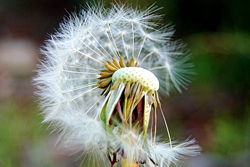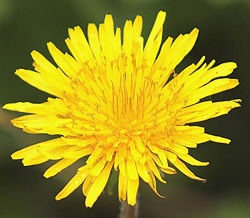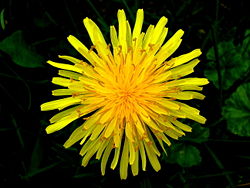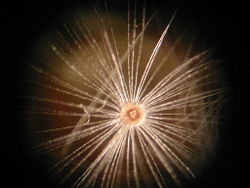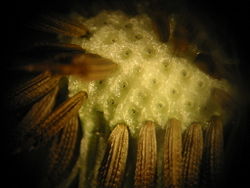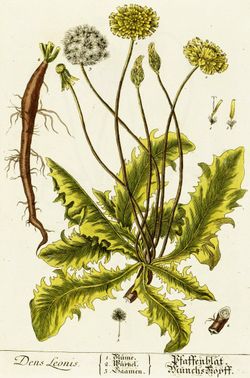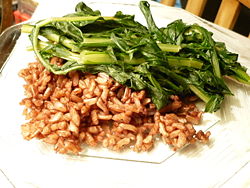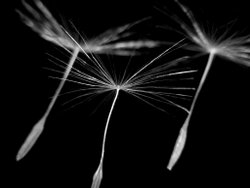Dandelion
2008/9 Schools Wikipedia Selection. Related subjects: Plants
| Dandelion | ||||||||||||||
|---|---|---|---|---|---|---|---|---|---|---|---|---|---|---|
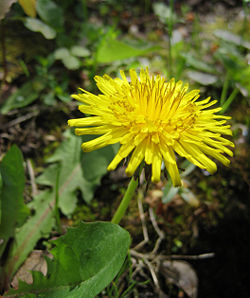 A flowering dandelion.
|
||||||||||||||
| Scientific classification | ||||||||||||||
|
||||||||||||||
| Species | ||||||||||||||
|
See text |
The common name Dandelion is given to members of the genus Taraxacum, a large genus of flowering plants in the family Asteraceae. In the Asteraceae (formerly Compositae) the "flowers" are morphologically a composite flower head consisting of many tiny flowers called florets. Dandelions are native to Europe and Asia and have been widely introduced elsewhere. Many Taraxacum species produce seeds asexually by apomixis, where the seeds are produced without pollination, resulting in offspring that are genetically identical to the parent plant.
Description
Dandelions are tap-rooted biennial or perennial herbaceous plants, native to temperate areas of the Northern Hemisphere of the Old World. They are commonly known as weeds or ruderals. The genus is taxonomically complex, with some botanists dividing the group into numerous macrospecies, and many more microspecies: approximately 235 apomictic and polyploid microspecies have been recorded in Great Britain and Ireland. Some botanists take a much narrower view and only accept a total of about 60 species.
The leaves are 5–25 cm long, simple and basal, entire or lobed, forming a rosette above the central taproot. As the leaves grow outward they push down the surrounding vegetation, such as grass in a lawn, which kills those plants by cutting off their access to sunlight. A bright yellow flower head, which is open in the daytime but closes at night, is borne singly on a hollow stem (scape) which rises 4–75 cm above the leaves and exudes a milky sap ( latex) when broken. A rosette may produce several flowering stems at a time. The flower head is 2–5 cm in diameter and consists entirely of ray florets. The flower head matures into a spherical "clock" (also known as a "wishie") containing many single-seeded fruits ( achenes). Each achene is attached to a pappus of fine hairs, which enable wind-aided dispersal over long distances.
Dandelions are used as food plants by the larvae of some species of Lepidoptera ( butterflies and moths). See List of Lepidoptera that feed on dandelions.
Away from their native regions, dandelions have become established in the Americas, Australia, and New Zealand, and are now common throughout all temperate regions.
History
Dandelions evolved about thirty million years ago in Eurasia
They have been used by humans for food and herbalism for much of recorded history.
Origin of the name
The English name dandelion is a corruption of the French dent de lion meaning lion's tooth, referring to the coarsely-toothed leaves. The names of the plant have the same meaning in several other European languages, such as Italian dente di leone, Spanish diente de león, Portuguese dente-de-leão, Norwegian Løvetann, and German Löwenzahn.
In modern French the plant is named pissenlit, which means "urinate in bed", apparently referring to its diuretic properties. Likewise, "pissabeds" is an English folkname for this plant, piscialletto in Italian and in Spanish it is known as the meacamas. Also, in the dialect of Veneto, Italy, it is known as pisacan, which translates to "dog pisses", referring to how common they are found at the side of pavements (source: Giulia Zanetti, native of Veneto), and in the dialect of Novara, Italy, it is known as soffione, which translates to "blowing", and refers to the habit of blowing the seeds from the stalk (source: Silvia Paracchini, native of Novara). Likewise, in Polish it is called "dmuchawiec" which comes from "dmuchać", "to blow" when in its seed state. Whilst in flower form the Poles know it as "Mlecz" a word derived from milk due to its milky sap.
In Turkish the dandelion is called karahindiba meaning "black endive".
Hungarian names are kutyatej ("dog milk", referring to the white sap found in the stem) and gyermekláncfű ("child's chain grass", referring to the habit of children to pick dandelions, remove the flowers, and make links out of the stems by "plugging" the narrow top end of the stem into the wider bottom end).
Lithuanian name kiaulpienė can be translated as "sow Sonchus" (because plant Sonchus that has white sap also in Lithuanian is pienė (from pienas "milk)) or "sow milk". In Finnish it is called 'voikukka' ("butter flower") referring to its buttery colour. In Swedish it is called 'maskros' ("worm rose"), likely referring to its low status (being mostly considered a weed) despite a fairly pleasant appearance.
In Dutch it is called paardebloem, meaning "horse-flower".
Seeds
The flower head is surrounded by bracts (sometimes mistakenly called sepals) in two series. The inner bracts are erect until the seeds mature, then flex down to allow the seeds to disperse; the outer bracts are always reflexed downward. Some species drop the "parachute" (called a pappus, modified sepals) from the achenes. Between the pappus and the achene, there is a stalk called a beak, which elongates as the fruit matures. The beak breaks off from the achene quite easily. After pollination, the dandelion flower dries out for about 1-2 days and then the seed-bearing parachutes expand and lift out of the dried flower head. The dried part of the flower drops off and the parachute ball opens into a full sphere. The parachute drops off when the seed strikes an obstacle. Often dandelions can be observed growing in a crevice near a wall, because the blowing fruits hit the wall and the feathery pappi drop off, sending the dandelion seeds to the base of the obstacle where they germinate. After the seed is released, the parachutes lose their feathered structure and take on a fuzzy, cotton-like appearance, often called "dandelion snow." While it was probably not developed evolutionarily, Dandelions seeds are often dispersed by young children, who often blow on or kick the clock.
Seed development and genetics
As previously mentioned, the taxonomical situation of the genus is quite complex, mainly because many dandelions are genetically triploid. An odd number of chromosomes usually is associated with sterility, but dandelions with this karyotype can reproduce without fertilization, by a process called apomixis. In these individuals flowers are inefficient vestigial structures, although they may still produce a small percentage of fertile pollen, keeping some genetic contact with sexual individuals. Diploid dandelions develop seeds after cross- pollination and are outcrossing, or self-incompatible. In most zones of southern Europe and Asia, dandelion populations are sexual or mixed sexual-apomictic, while in northern countries only triploid and tetraploid apomicts are present, as is in the zones where it is not native. This seems to be linked to higher temperatures, survival of pre-glacial populations and human impact, but the subject is still being studied.
There are usually 54 to 172 seeds produced per head, but a single plant can produce more than 2000 seeds a year. It has been estimated that more than 97 000 000 seeds/ hectare could be produced every year by a dense stand of dandelions.
Uses
While the dandelion is considered a weed by most gardeners and lawn owners, the plant does have several culinary uses, and the specific name officinalis refers to its value as a medicinal herb. Dandelions are grown commercially on a small scale as a leaf vegetable. The leaves (called dandelion greens) can be eaten cooked or raw in various forms, such as in soup or salad. They are probably closest in character to mustard greens. Usually the young leaves and unopened buds are eaten raw in salads, while older leaves are cooked. Raw leaves have a slightly bitter taste. Dandelion salad is often accompanied with hard boiled eggs. The leaves are high in vitamin A, vitamin C and iron, carrying more iron and calcium than spinach.
Dandelion flowers can be used to make dandelion wine, for which there are many recipes. It has also been used in a saison ale called Pissenlit (literally "wet the bed" in French) made by Brasserie Fantôme in Belgium. Another recipe using the plant is dandelion flower jam. Ground roasted dandelion root can be used as a coffee substitute. Dandelion root is a registered drug in Canada, sold principally as a diuretic. A leaf decoction can be drunk to "purify the blood", for the treatment of anaemia, jaundice, and also for nervousness. Drunk before meals, dandelion root coffee is claimed to stimulate digestive functions and function as a liver tonic. " Dandelion and Burdock" is a soft drink that has long been popular in the United Kingdom with authentic recipes sold by health food shops. It is unclear whether cheaper supermarket versions actually contain extracts of either plant.
The milky latex has been used as a mosquito repellent;the milk has also been used to treat warts, as a folk remedy.
Yellow or green dye colours can be obtained from the flowers but little colour can be obtained from the roots of the plant.
Antioxidant properties
Dandelion contains luteolin, an antioxidant, and has demonstrated antioxidant properties without cytotoxicity.
Caffeic acid and carcinogenicity
Caffeic acid is a secondary plant metabolite produced in dandelion, yarrow, horsetail and whitethorn. Despite its name, it is unrelated to caffeine. Recent studies have revealed this acid may be carcinogenic. When caffeic acid was tested for carcinogenicity by oral administration in mice, renal cell adenomas appeared in females, and a high incidence of renal tubular cell hyperplasia occurred in animals of each sex. However, more recent research shows that bacteria present in the rodents' intestines may alter the formation of metabolites of caffeic acid. There have been no known ill effects of caffeic acid in humans.
Bees
Dandelions are important plants for bees. Not only is their Template:Phenology used as an indicator that the honey bee season is starting, but they are also an important source of nectar and pollen early in the season.
False dandelions
Dandelions are so similar to catsears (Hypochaeris) that catsears are also known as "false dandelions." Both plants carry similar flowers which form into windborne seeds. However, dandelion flowers are borne singly on unbranched, hairless and leafless, hollow stems, while catsear flowering stems are branched, solid and carry bracts. Both plants have a basal rosette of leaves and a central taproot. However, the leaves of dandelions are smooth or glabrous, whereas those of catsears are coarsely hairy.
Other plants with superficially similar flowers include hawkweeds (Hieracium) and hawksbeards (Crepis). These are both readily distinguished by their branched flowering stems which are usually hairy and bear leaves.
Selected species
- Taraxacum albidum, a white-flowering Japanese dandelion.
- Taraxacum californicum, the endangered California dandelion
- Taraxacum officinale (syn. T. officinale subsp. vulgare), Common Dandelion. Found in many forms.
- Taraxacum japonicum, Japanese dandelion. No ring of smallish, downward-turned leaves under the flowerhead.
- Taraxacum laevigatum (syn. T. erythrospermum), Red-seeded Dandelion; achenes reddish brown and leaves deeply cut throughout length. Inner bracts' tips are hooded.

